|
-
 Oil Change. How Important Is Temperature? Oil Change. How Important Is Temperature?
The manual says that the engine should be warm before changing the oil. They also says that if the engine is already warm, then to start it and idle for 30 seconds to get all the oil back into the tank. Huh? If it’s already warm from being run anyway, then what’s the point of the 30 second thing? And how important is it to have warm oil anyway? I know it makes it flow out faster, but I can’t begin to count how many Saturday mornings I have driven my car up on ramps cold, pulled the plug and filter and let it drain. Sometimes I’ll let it set for 15 minutes or so to give it all a chance to come out. Why would the Spyder be any different? Info in signature.
~~2010 RS SE5 My first Spidey, but not my first ride~~
The trigger’s been pulled. We have to
get there before the hammer falls.
-
Very Active Member


I have changed bike oil cold, hot, and in between. Never had an oil related engine failure. I usually take the Spyder for a ten mile or so ride and then let it sit for an hour or so until most parts have cooled off. I'm not burning my fingers for anyone. The oil is still warm enough to flow well.
-
Very Active Member


The TEMP gauge is not needed to check or decide the oil Temp. .... When you decide to drain the oil system, get everything ready ... start the bike let idle for 3-4 min. and this will be fine ....UNLESS you change your oil when the ambient temp is 50 F or less then let it idle an additional 2-3 min. .... PS - I let my Spyder sit for a couple of days after I pull the drain plugs ..... Mike 
-
Ozzie Ozzie Ozzie
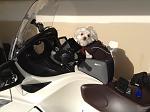
-

 Originally Posted by Peter Aawen

The oil temperature is probably more critical when you are CHECKING the oil level rather than just CHANGING the oil; so long as you ONLY put in a touch LESS oil than the recommended quantity of oil and then do the 'ride then check' thing before deciding to add too much more oil afterwards! 
This is confusing to me. If the bike has sat for any length of time, why wouldn’t the dipstick show the actual level? If it’s a dry sump, then wouldn’t all the oil be in the tank? When the motor is running, it sucks oil out of the tank, circulates it through the engine and then back into the tank, right? So if I turn the motor off after a ride and THEN check my oil, how would that be any different than letting the bike sit for several hours (or days) and then checking it? Does hot oil take up more volume?
~~2010 RS SE5 My first Spidey, but not my first ride~~
The trigger’s been pulled. We have to
get there before the hammer falls.
-
Very Active Member


 Originally Posted by DaniBoy

This is confusing to me. If the bike has sat for any length of time, why wouldn’t the dipstick show the actual level? If it’s a dry sump, then wouldn’t all the oil be in the tank? When the motor is running, it sucks oil out of the tank, circulates it through the engine and then back into the tank, right? So if I turn the motor off after a ride and THEN check my oil, how would that be any different than letting the bike sit for several hours (or days) and then checking it? Does hot oil take up more volume?
Peter is correct. ..... whether the oil is hot, really isn't the issue .... it's how the dry sump BRP system is designed to work ..... Mike 
Last edited by BLUEKNIGHT911; 01-16-2023 at 10:32 AM.
-
Ozzie Ozzie Ozzie


 Originally Posted by DaniBoy

This is confusing to me. If the bike has sat for any length of time, why wouldn’t the dipstick show the actual level? If it’s a dry sump, then wouldn’t all the oil be in the tank? When the motor is running, it sucks oil out of the tank, circulates it through the engine and then back into the tank, right? So if I turn the motor off after a ride and THEN check my oil, how would that be any different than letting the bike sit for several hours (or days) and then checking it? Does hot oil take up more volume?
You're getting close, but it's really only when the scavenge Pumps are running that all the oil not actively circulating is in the tank/reservoir - as soon as you turn the engine off, the scavenge pumps stop running, and the oil starts leaking back into the scavenge/pick-up areas deep inside the engine block... but there's no non-return valve on the bottom of the reservoir nor is there a single sump for it to run into, so your oil can just 'disappear' into the block until you start up again - and that means that if you filled it to the full mark in the reservoir after it'd been sitting for a few days, there's a very good chance that it now might be dangerously and possibly even very expensively OVER-full as soon as the scavenge pumps start pumping it back into circulation & trying to force too much into too small a container! 
And YES, hot oil DOES take up more volume than 'cold' oil (or oil at its ICE operating temperature anyway  ) and THAT, teamed with the fact that the reservoir/tank is only showing an accurate indication of how much oil is in the system for a few minutes after you turn the engine off, means that if your oil is not at OIL operating temperature when you do the level check, then you might get a substantially lower level reading than you'd get once the scavenge pumps start up again and your oil does reach operating temperature - and remember, that's the OIL's operating temperature too, which has little to do with the coolant operating temperature!! So if you add oil to your reservoir cos the level looks low when the oil is cold and the engine's been sitting for more than a few minutes, you might be over-filling it.... how much over-full is anyone's guess, as is exactly how much excess oil it will take to hydraulic the engine & blow the crank or a rod or two right out of the bottom of the block!! ) and THAT, teamed with the fact that the reservoir/tank is only showing an accurate indication of how much oil is in the system for a few minutes after you turn the engine off, means that if your oil is not at OIL operating temperature when you do the level check, then you might get a substantially lower level reading than you'd get once the scavenge pumps start up again and your oil does reach operating temperature - and remember, that's the OIL's operating temperature too, which has little to do with the coolant operating temperature!! So if you add oil to your reservoir cos the level looks low when the oil is cold and the engine's been sitting for more than a few minutes, you might be over-filling it.... how much over-full is anyone's guess, as is exactly how much excess oil it will take to hydraulic the engine & blow the crank or a rod or two right out of the bottom of the block!!  Don't believe this can happen if you will, but I've personally seen a few of engine's that exactly this has happened to, so I'm not gonna risk it! Don't believe this can happen if you will, but I've personally seen a few of engine's that exactly this has happened to, so I'm not gonna risk it! 
All of which adds up to the need to make sure you don't ever add more oil than specified during an oil change; and that you really should ALWAYS use the approved Oil level check procedure that calls for the engine to have been run for some time in order to bring the oil up to IT's operating temperature by running (preferably at highway speeds/revs) for 10-30 mins before shutting it down to do the check; and then you still need to check the oil level in the reservoir within a few minutes of that shut-down, cos if you don't do that, you stand a pretty good chance of over-filling the engine with oil and that can mean dirty things happen, if not nasty & expensive things happening to your engine!! 
Yeah, I know all this could have been done differently by BRP/Rotax, but for whatever reason, it hasn't been, so you really have little choice but to work with what you've got, cos none of this is easy (or cheap!) to change...  But it's really not all that hard to make it your practice to hold back 250ml or so of oil from the recommended fill amount when you do every oil change, then knowing that you've got enough in there to be safe, run the engine/ride the bike for the necessary time before checking it using the approved procedure and topping up ONLY as necessary to put your oil level somewhere between the Low/Add mark and the Full mark, but NEVER OVER the Full mark on the dipstick! And then once you know you've got it somewhere in the middle of that ADD-FULL range, simply make a practice of checking your oil level AFTER you've gone on a reasonably good ride - cos if you check it when you stop like that, then unless there's a puddle of oil underneath the bike the next time you go to ride the bike, be it a day, a few weeks, or even some months later, the odds are well in your favour that there'll be enough oil in there for you to start & run the engine safely! But it's really not all that hard to make it your practice to hold back 250ml or so of oil from the recommended fill amount when you do every oil change, then knowing that you've got enough in there to be safe, run the engine/ride the bike for the necessary time before checking it using the approved procedure and topping up ONLY as necessary to put your oil level somewhere between the Low/Add mark and the Full mark, but NEVER OVER the Full mark on the dipstick! And then once you know you've got it somewhere in the middle of that ADD-FULL range, simply make a practice of checking your oil level AFTER you've gone on a reasonably good ride - cos if you check it when you stop like that, then unless there's a puddle of oil underneath the bike the next time you go to ride the bike, be it a day, a few weeks, or even some months later, the odds are well in your favour that there'll be enough oil in there for you to start & run the engine safely! 
Make sense?? 
Last edited by Peter Aawen; 01-16-2023 at 11:10 PM.
2013 RT Ltd Pearl White
Ryde More, Worry Less!
-
SpyderLovers Ambassador
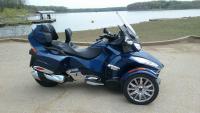
 Warm Oil Warm Oil
 ...Well, I go with warm oil to get the full effect of the oil change. Why? Warm oil will drain a little quicker than the cold. The dirty particulars will be 'suspended' in the oil much longer and drain out with the oil. Do to the BRP system you can get more of the old dirty oil drained. ...Well, I go with warm oil to get the full effect of the oil change. Why? Warm oil will drain a little quicker than the cold. The dirty particulars will be 'suspended' in the oil much longer and drain out with the oil. Do to the BRP system you can get more of the old dirty oil drained.
This is how and why I choose to change my Spyder oil.
You can do whatever you wish.
Have yourself a Blessed Day. .....
ENJOY YOUR LIFE WITH A SPYDER
Ryde with a Friend and be Safe
My Spyder ..... 'Little Blue-Boy'
-

If I understand this correctly, when we change our oil by the book, we are leaving approximately 250 ml (8 ozs) of old dirty oil in some hidden sumps that later mixes in with our nice fresh oil. That's like dumping a cup of old dishwater into the sink when you wash your dinner plate. "yummy" JMHO!  Bill Bill
2020 RTL Chrome, Marsala Red "Non-Directional Tires, Centramatic Balancers"
Front- Kumho KH-16 175/55r15 @17psi, Rear-General Altimax RT-45 215/60r15 @20psi
BaJa Ron Ultra 3 pcs sway bar kit
7jurock 25" tinted windscreen w/flip
Frogman Dave's "Signal Button"
 If in Doubt, Don't Do It! If in Doubt, Don't Do It! 
" Pros: Excellent Bug Killer, Cons: Pizz Poor Pothole Dodger"
-
SpyderLovers Ambassador

 You Nailed It You Nailed It
 Originally Posted by Knizar

If I understand this correctly, when we change our oil by the book, we are leaving approximately 250 ml (8 ozs) of old dirty oil in some hidden sumps that later mixes in with our nice fresh oil. That's like dumping a cup of old dishwater into the sink when you wash your dinner plate. "yummy" JMHO!  Bill
That's the way it works. BRP Spyders are a little different than the automobile oil drain pan. But it's not 'rocket science'. Just do it the better way.
Stay Healthy. ....
ENJOY YOUR LIFE WITH A SPYDER
Ryde with a Friend and be Safe
My Spyder ..... 'Little Blue-Boy'
-
Very Active Member


 Originally Posted by DaniBoy

This is confusing to me. If the bike has sat for any length of time, why wouldn’t the dipstick show the actual level? If it’s a dry sump, then wouldn’t all the oil be in the tank? When the motor is running, it sucks oil out of the tank, circulates it through the engine and then back into the tank, right? So if I turn the motor off after a ride and THEN check my oil, how would that be any different than letting the bike sit for several hours (or days) and then checking it? Does hot oil take up more volume?
Let me give you my explanation. The engine stores oil in two locations, the crankcase and the reservoir tank. The tank is higher than the crankcase. When the engine is running oil gets pumped from the tank to all the engine parts. It then drains down to the crankcase where sump pumps pick it up and pump it back to the tank. The tank is connected by a small drain line to the crankcase so when the engine is stopped the oil in the tank slowly drains down into the crankcase. The dipstick is in the tank, not the crankcase. That's why you need the check the oil level shortly after shutting off the engine before very much oil has drained down. In fact, if the engine is shut down for months and you check the oil level you will see no oil on the dipstick. But as soon as you have run the engine for several minutes you will then see oil on the dipstick.
The temperature requirement for changing the oil is to make sure as much as is prescribed of the oil in the reservoir has drained down. The reason some oil doesn't get drained is because the reservoir does not drain 100%. That's to make sure there is always oil available for lubrication when you start the engine.
The primary reason, as I know it, for using a dry sump system is to avoid having an oil pan hanging down below the engine. After all, an oil pan is simply a place to store oil. With a dry sump system the oil is stored up and away from below the engine. This makes for a safer storage area and makes it possible to set the engine lower in the vehicle for a lower center of gravity.
Last edited by IdahoMtnSpyder; 01-16-2023 at 04:24 PM.
Reason: added oil pan comment
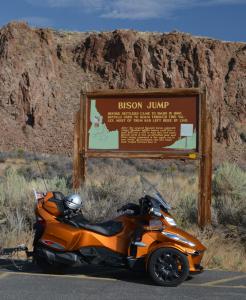
2014 Copper RTS
Tri-Axis bars, CB, BajaRon sway bar & shock adjusters, SpyderPop's Bumpskid, NBV peg brackets, LED headlights and modulator, Wolo trumpet air horns, trailer hitch, custom trailer harness, high mount turn signals, Custom Dynamics brake light, LED turn signal lights on mirrors, LED strip light for a dash light, garage door opener, LED lights in frunk, trunk, and saddlebags, RAM mounts and cradles for tablet (for GPS) and phone (for music), and Smooth Spyder belt tensioner.
-
Active Member


 Originally Posted by IdahoMtnSpyder

Let me give you my explanation. The engine stores oil in two locations, the crankcase and the reservoir tank. The tank is higher than the crankcase. When the engine is running oil gets pumped from the tank to all the engine parts. It then drains down to the crankcase where sump pumps pick it up and pump it back to the tank. The tank is connected by a small drain line to the crankcase so when the engine is stopped the oil in the tank slowly drains down into the crankcase. The dipstick is in the tank, not the crankcase. That's why you need the check the oil level shortly after shutting off the engine before very much oil has drained down. In fact, if the engine is shut down for months and you check the oil level you will see no oil on the dipstick. But as soon as you have run the engine for several minutes you will then see oil on the dipstick.
The temperature requirement for changing the oil is to make sure as much as is prescribed of the oil in the reservoir has drained down. The reason some oil doesn't get drained is because the reservoir does not drain 100%. That's to make sure there is always oil available for lubrication when you start the engine.
The primary reason, as I know it, for using a dry sump system is to avoid having an oil pan hanging down below the engine. After all, an oil pan is simply a place to store oil. With a dry sump system the oil is stored up and away from below the engine. This makes for a safer storage area and makes it possible to set the engine lower in the vehicle for a lower center of gravity.
Great explanation, makes sense now.
2023 Ryker Rally - Heritage White III
Sport Windshield
GPS Holder
-
Active Member
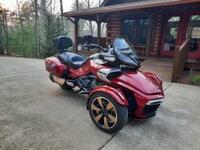

So... been rainy and cold but need to change oil so ryding is out. I could let it just idle in the garage, but in order to speed up the warming process, this is what I did.
Let it idle and placed two space heaters, (small, low power) one on each side at each radiator. Less than 5 minutes to get to operating temp.
Current: "Scarlett", 2017 Can Am  F3-T, SE6, Intense Red Pearl. F3-T, SE6, Intense Red Pearl. 
BRP heated grips, DIY brake light strip and turn signal strips, Chrome/LED brake light tag frame, SpyderPops bumpskid, Baja Ron swaybar and billet links, Lamonster Third Peg, BRP Adjustable Passenger Backrest, SpyderPops Missing Belt Guard, ShowChrome oversize brake pedal, TricLED foglights.
Previous: "Synthia", 2014 Can Am Spyder RT, SM6, Pearl White.
-
Ozzie Ozzie Ozzie

Last edited by Peter Aawen; 02-02-2023 at 08:38 PM.
2013 RT Ltd Pearl White
Ryde More, Worry Less!
-
SpyderLovers Sponsor


 Originally Posted by Peter Aawen

That probably would've been the COOLANT's operating temperature, and not necessarily the OIL's operating temperature! 
Getting the OIL up to its operating temperature (which is somewhat higher than coolant operating temp  ) & ideal Oil change temperature generally takes at least two (2) fan on/off cycles AFTER the coolant temp has hit the middle of the temp gauge for the oil to reach its ideal operating temp/oil change temp; or it takes about 30 minutes of riding time at Highway speed revs with some gear-changing thrown in!  Any lower temp will mean the oil can't flow as well as it should and so it won't really drain as well, even if it does sorta work... maybe... hopefully... 
Just Sayin' 
This is very common. People don't realize that coolant temp is not oil temp. The cooling system has a thermostat that restricts flow to the engine. it does not open up until the coolant temp reaches 195 degrees. The top of the engine gets hot quickly and so does the coolant. But the oil will be stone cold unless you idle for a long time (not good) or ride for 10 miles or so.
Shop Ph: 423-609-7588 (M-F, 8-5, Eastern Time)
Only SLOW people have to leave on time...


-
Very Active Member
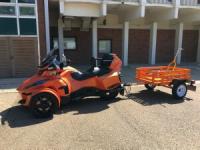

 Originally Posted by BajaRon

This is very common. People don't realize that coolant temp is not oil temp. The cooling system has a thermostat that restricts flow to the engine. it does not open up until the coolant temp reaches 195 degrees. The top of the engine gets hot quickly and so does the coolant. But the oil will be stone cold unless you idle for a long time (not good) or ride for 10 miles or so.
Copied over from an experiment I did in 2021. It was on checking the oil but the temps are shown.
_______
Since the subject of checking the oil level came up I guess this is as good a place to post an experiment I did.
First let me say that I proved myself wrong in something I had said before about idling for 10 minutes being as good as a ride. It's not.
There actually is a reason for following the procedure to check the oil.
Oil Temperature 83.8F Low mark on dipstick Not started for a little over 24 hours
Oil Temperature 151.3 F 1/2 way between low and full Idled for 10 minutes Fan did cycle on
Oil Temperature 211.8 F Full mark on dipstick 9 mile ride
Oil Temperature 206.9 F Full mark 25 mile ride
-
Very Active Member


Sorry to be contrarian (not!) but based on what I find about engine temperature and oil viscosity you guys are overthinking the situation. Yes the engine needs to be warmed up to assure a good drain, but it does not need to be hot. Look at this graph from https://www.kewengineering.co.uk/Aut..._explained.htm. Company home page is https://www.kewengineering.co.uk. Google showed a whole bunch of other viscosity vs temp graphs, all with nearly identical trend lines so this graph is representative.
Viscosity vs temp.jpg
According to EdMat's measurements the oil was at about 150° F after 10 minutes of idling, and about 210° F after riding. 150F is about 65C and 212F is 100C. All oil specs use 100C for determining viscosity at operating temperature. If you look close at the graph you will see very little drop in viscosity from 65° C to 100° C. So, I argue that from a practical standpoint as far as assuring draining as much oil as possible from the engine, there will be an almost immeasurable difference in the amount of oil that will drain at 200F vs 150F. And, since the viscosity after idling is so close to that at full temperature, there will be negligible, if any, less lubrication taking place at idle vs. full operating temp.

2014 Copper RTS
Tri-Axis bars, CB, BajaRon sway bar & shock adjusters, SpyderPop's Bumpskid, NBV peg brackets, LED headlights and modulator, Wolo trumpet air horns, trailer hitch, custom trailer harness, high mount turn signals, Custom Dynamics brake light, LED turn signal lights on mirrors, LED strip light for a dash light, garage door opener, LED lights in frunk, trunk, and saddlebags, RAM mounts and cradles for tablet (for GPS) and phone (for music), and Smooth Spyder belt tensioner.
-
SpyderLovers Sponsor


 Originally Posted by IdahoMtnSpyder

Sorry to be contrarian (not!) but based on what I find about engine temperature and oil viscosity you guys are overthinking the situation. Yes the engine needs to be warmed up to assure a good drain, but it does not need to be hot. Look at this graph from https://www.kewengineering.co.uk/Aut..._explained.htm. Company home page is https://www.kewengineering.co.uk. Google showed a whole bunch of other viscosity vs temp graphs, all with nearly identical trend lines so this graph is representative.
Viscosity vs temp.jpg
According to EdMat's measurements the oil was at about 150° F after 10 minutes of idling, and about 210° F after riding. 150F is about 65C and 212F is 100C. All oil specs use 100C for determining viscosity at operating temperature. If you look close at the graph you will see very little drop in viscosity from 65° C to 100° C. So, I argue that from a practical standpoint as far as assuring draining as much oil as possible from the engine, there will be an almost immeasurable difference in the amount of oil that will drain at 200F vs 150F. And, since the viscosity after idling is so close to that at full temperature, there will be negligible, if any, less lubrication taking place at idle vs. full operating temp.
Can't disagree with any of this. Part of this issue is that we have several things going on here. Changing oil has a different set of, what I consider, necessary parameters than checking oil level. So, the information in your chart has a different application depending upon what you are trying to accomplish.
For changing your oil, it is not necessary to have really hot oil. But it is a good idea to get it warm and stir up the sediments and impurities which you are attempting to remove from the system. It is very important to get the oil up to operating temperature for checking level for several reasons. And coolant temperature does not necessarily correlate to oil temperature. Especially if you've used idle to achieve it. Idling an engine is not good for it. And is usually the worst way to get things warmed up. Again, for a number of reasons.
Shop Ph: 423-609-7588 (M-F, 8-5, Eastern Time)
Only SLOW people have to leave on time...


-

 Originally Posted by IdahoMtnSpyder

Let me give you my explanation. The engine stores oil in two locations, the crankcase and the reservoir tank. The tank is higher than the crankcase. When the engine is running oil gets pumped from the tank to all the engine parts. It then drains down to the crankcase where sump pumps pick it up and pump it back to the tank. The tank is connected by a small drain line to the crankcase so when the engine is stopped the oil in the tank slowly drains down into the crankcase.
........
My manual says there is an oil drain plug for the sump cover and one for the clutch cover. Do either of these correlate with the crankcase and the reservoir you noted? If not, where is the engine oil stored that is drained by the clutch cover plug and how does it fit into your example? Thanks
Last edited by Peter Aawen; 02-03-2023 at 06:58 PM.
Reason: Fixed quote display ;-)
-
Ozzie Ozzie Ozzie


 Originally Posted by svspyder

My manual says there is an oil drain plug for the sump cover and one for the clutch cover. Do either of these correlate with the crankcase and the reservoir you noted? If not, where is the engine oil stored that is drained by the clutch cover plug and how does it fit into your example? Thanks
There are Scavenge Pumps that pick up oil from the bottom of the clutch and the crankcase while the engine is running, and that oil is ultimately delivered to the Reservoir. Both of those plugs you mention are lower than the bottom of the Reservoir, and there's no 'non-return valve' on the outlet at bottom of the reservoir either - so when you pull those plugs, you drain the oil from the Reservoir via both the crankcase & the clutch... The engine oil is 'stored' in the Reservoir, but because of that 'lack of a non-return valve on the bottom of the Reservoir feature', once the engine stops running, oil will start percolating back down into the Scavenge pump pick-up areas, where the crankcase & clutch plugs are situated at the bottom of each of those two areas.... 
Last edited by Peter Aawen; 02-03-2023 at 07:50 PM.
Reason: btom - bottom ;-/
2013 RT Ltd Pearl White
Ryde More, Worry Less!
-
Very Active Member


 Originally Posted by svspyder

My manual says there is an oil drain plug for the sump cover
On most engines we call that the oil pan! It's on the bottom side of the crankcase.

2014 Copper RTS
Tri-Axis bars, CB, BajaRon sway bar & shock adjusters, SpyderPop's Bumpskid, NBV peg brackets, LED headlights and modulator, Wolo trumpet air horns, trailer hitch, custom trailer harness, high mount turn signals, Custom Dynamics brake light, LED turn signal lights on mirrors, LED strip light for a dash light, garage door opener, LED lights in frunk, trunk, and saddlebags, RAM mounts and cradles for tablet (for GPS) and phone (for music), and Smooth Spyder belt tensioner.
-
SpyderLovers Sponsor


 Originally Posted by svspyder

My manual says there is an oil drain plug for the sump cover and one for the clutch cover. Do either of these correlate with the crankcase and the reservoir you noted? If not, where is the engine oil stored that is drained by the clutch cover plug and how does it fit into your example? Thanks
We call the 'Sump Cover' the oil pan. Not exactly correct, technically. But a Rose by any other name... There is a drain on the clutch cover. But the amount of oil it retains is so small that it isn't worth the effort to pull it. Everyone ignores this one. And most don't even know it exists. Not a problem.
Shop Ph: 423-609-7588 (M-F, 8-5, Eastern Time)
Only SLOW people have to leave on time...


-

 Originally Posted by BajaRon

We call the 'Sump Cover' the oil pan. Not exactly correct, technically. But a Rose by any other name... There is a drain on the clutch cover. But the amount of oil it retains is so small that it isn't worth the effort to pull it. Everyone ignores this one. And most don't even know it exists. Not a problem.
Now I'm really confused. My 2015 RT SE6 manual refers to the oil sump cover drain plug and a clutch cover drain plug. Both plugs are to be removed during oil change. Last oil change I got about 4qts oil from oil sump plug and about 1qt from the clutch cover. How can we ignore the clutch cover plug during oil changes??
-
SpyderLovers Sponsor


 Originally Posted by svspyder

Now I'm really confused. My 2015 RT SE6 manual refers to the oil sump cover drain plug and a clutch cover drain plug. Both plugs are to be removed during oil change. Last oil change I got about 4qts oil from oil sump plug and about 1qt from the clutch cover. How can we ignore the clutch cover plug during oil changes??
If you got 1 quart from the 'Clutch Cover' drain plug. Then it was the oil sump plug that you pulled. You might get 2 ounces from the clutch mechanism plug. I'm not sure the 1330 has the clutch drain that the 998 had.
Shop Ph: 423-609-7588 (M-F, 8-5, Eastern Time)
Only SLOW people have to leave on time...


-
Very Active Member


 Originally Posted by Little Blue

 ...Well, I go with warm oil to get the full effect of the oil change. Why? Warm oil will drain a little quicker than the cold. The dirty particulars will be 'suspended' in the oil much longer and drain out with the oil. Do to the BRP system you can get more of the old dirty oil drained.
This is how and why I choose to change my Spyder oil.
You can do whatever you wish.
Have yourself a Blessed Day. ..... 
This.
IMHO, draining it warm is more beneficial because to the reasons listed above.
I usually take my vehicles out for a quick 12 mile/10 minute jaunt prior to changing the oil. It's warm, but not scalding.
SIGNATURE PIC CURRENTLY UNDER CONSTRUCTION
2016 Toyota Sienna SE - hers
2002 BMW 325i - his
1994 Chevrolet Silverado K1500 Sportside Z71 - whoevers vehicle is in the shop
2009 Harley-Davidson Sportster XL883 Low (Vivid Black) - his
2018 Can-Am Spyder RT Limited - hers
2007 Harley-Davidson Sportster XL883 Low (Pearl White) - hers (SOLD 02/29/20)
2011 Tao Tao 50 - whoevers bike is in the shop
2007 Reinell 186 FNS - the dog's
1995 Fleetwood Flair 27R - EVERYBODY'S !

 Posting Permissions
Posting Permissions
- You may not post new threads
- You may not post replies
- You may not post attachments
- You may not edit your posts
-
Forum Rules
|




 Reply With Quote
Reply With Quote







 ) and THAT, teamed with the fact that the reservoir/tank is only showing an accurate indication of how much oil is in the system for a few minutes after you turn the engine off, means that if your oil is not at OIL operating temperature when you do the level check, then you might get a substantially lower level reading than you'd get once the scavenge pumps start up again and your oil does reach operating temperature - and remember, that's the OIL's operating temperature too, which has little to do with the coolant operating temperature!! So if you add oil to your reservoir cos the level looks low when the oil is cold and the engine's been sitting for more than a few minutes, you might be over-filling it.... how much over-full is anyone's guess, as is exactly how much excess oil it will take to hydraulic the engine & blow the crank or a rod or two right out of the bottom of the block!!
) and THAT, teamed with the fact that the reservoir/tank is only showing an accurate indication of how much oil is in the system for a few minutes after you turn the engine off, means that if your oil is not at OIL operating temperature when you do the level check, then you might get a substantially lower level reading than you'd get once the scavenge pumps start up again and your oil does reach operating temperature - and remember, that's the OIL's operating temperature too, which has little to do with the coolant operating temperature!! So if you add oil to your reservoir cos the level looks low when the oil is cold and the engine's been sitting for more than a few minutes, you might be over-filling it.... how much over-full is anyone's guess, as is exactly how much excess oil it will take to hydraulic the engine & blow the crank or a rod or two right out of the bottom of the block!! 


 Bill
Bill








